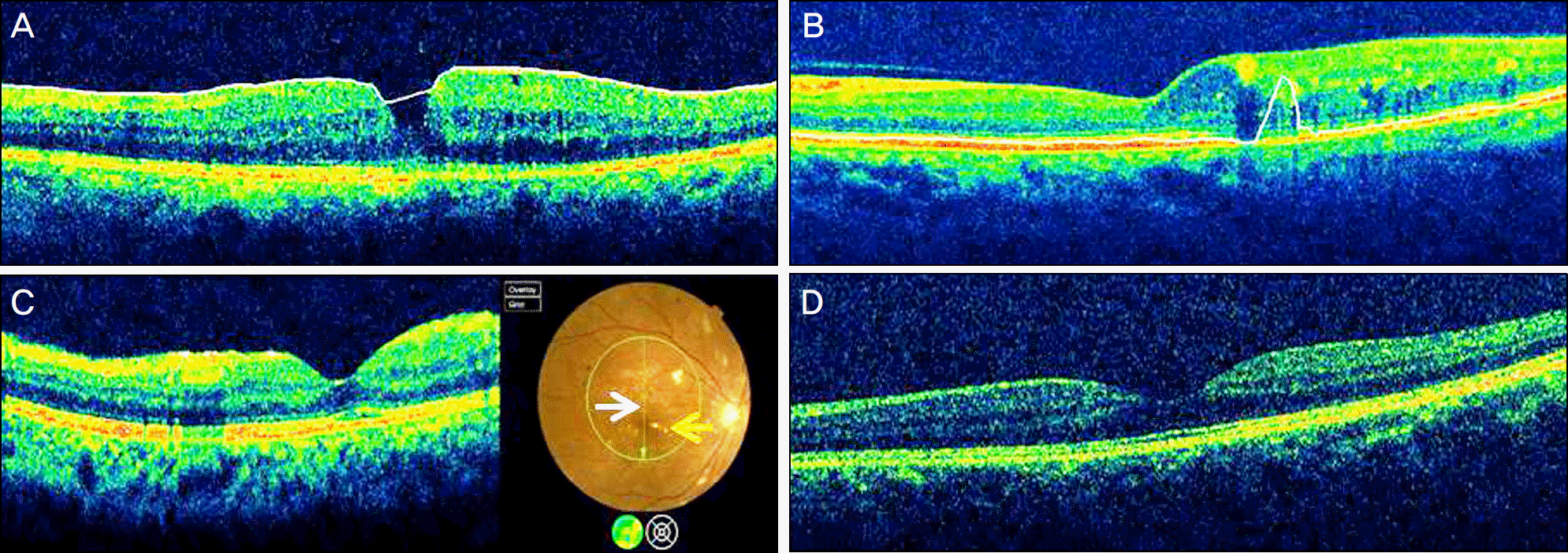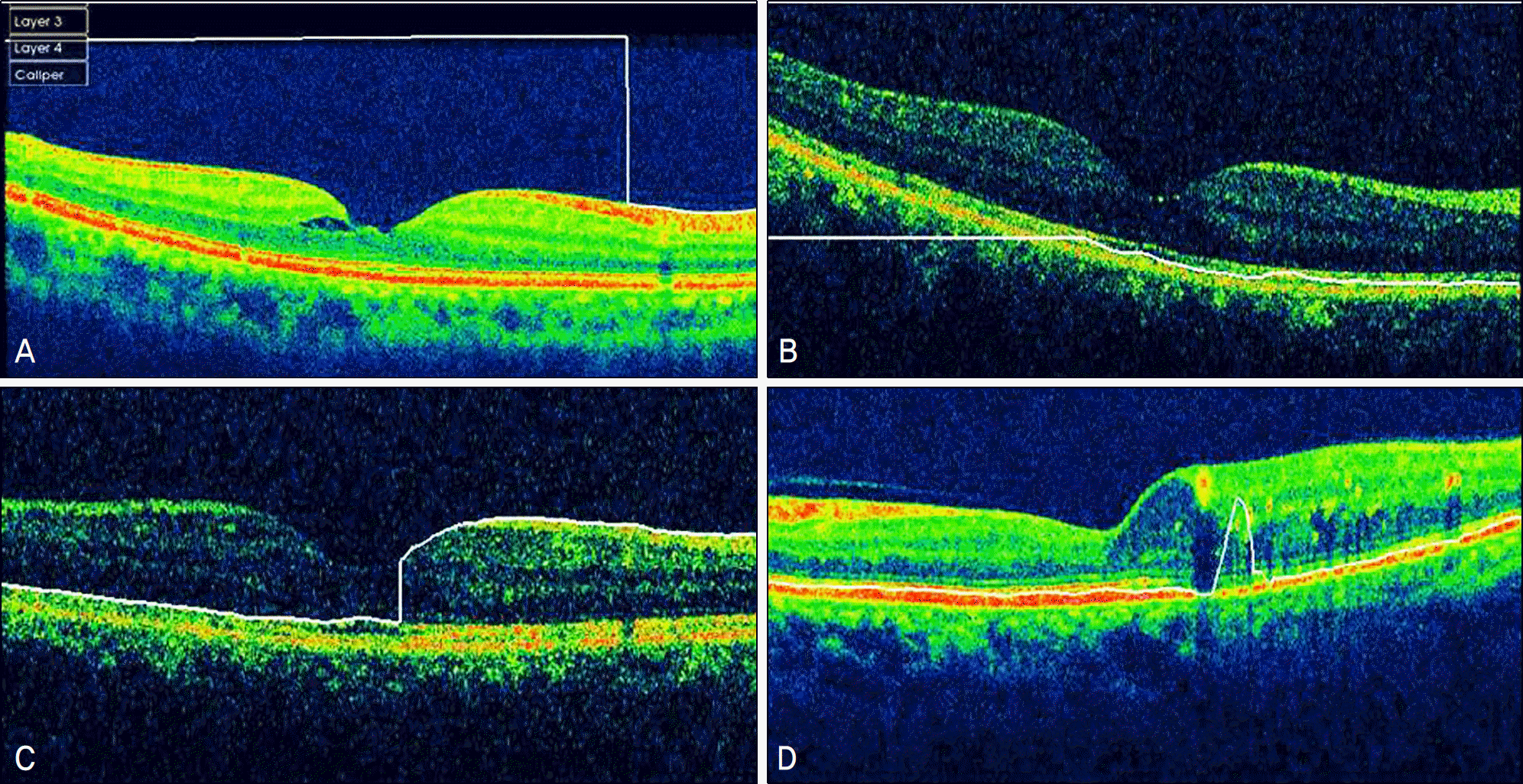Abstract
Purpose
To report the frequency, severity and various types of artifacts associated with spectral-domain optical coherence tomography (SD-OCT) based on macular pathologies.
Methods
Data was collected retrospectively from 116 eyes of 116 subjects. SD-OCT (3D-1000, Topcon Corp., Japan) imaging was performed in 40 healthy eyes, 45 eyes with intraretinal pathology (IRP) and 31 eyes with subretinal pathology (SRP). The scan protocol was 12×6 mm radial scan. The frequency and types of artifacts were investigated in each scan and were analyzed based on macular disease. Additionally, the effect of artifacts on the measurement of macular thickness was studied.
Results
Errors occurred in 77 eyes (66.38%). Inner retinal boundary misidentification (IRBM) was the most common error (25.86%), with the frequencies of other types of artifacts being 10.34% for off-center fixation, 15.52% for degraded image and 8.6% for outer retinal boundary misidentification (ORBM). The overall error rate of SD-OCT in the retinal pathology group was much higher than that in the normal group. Macular thickness was underestimated in the IRP group because the outer retinal boundary of the IRP group tended to be misidentified toward the inner retina (p<0.01).
Go to : 
References
2. Leung CK, Chan WM, Chong KK, et al. Alignment artifacts in optical coherence tomography analyzed images. Ophthalmology. 2007; 114:263–70.

3. Patel PJ, Chen FK, Cruz L, Tufail A. Segmentation error in Stratus optical coherence tomography for neovascular age-related macular degeneration. Invest Ophthalmol Vis Sci. 2009; 50:399–404.

4. Ghazi NG, Kirk T, Allam S, Yan G. Quantification of error in optical coherence tomography central macular thickness in wet age-related macular degeneration. Am J Ophthalmol. 2009; 148:90–6.
5. Ray R, Stinnett SS, Jaffe GJ. Evaluation of image artifact produced by optical coherence tomography of retinal pathology. Am J Ophthalmol. 2005; 139:18–29.

6. Sadda SR, Wu Z, Walsh AC, et al. Errors in retinal thickness measurements obtained by optical coherence tomography. Ophthalmology. 2006; 113:285–93.

7. Sadda SR, Joeres S, Wu Z, et al. Error correction and quantitative subanalysis of optical coherence tomography data using computer assisted grading. Invest Ophthalmol Vis Sci. 2007; 48:839–48.
8. Domalpally A, Danis RP, Zhang B, et al. Quality issue in interpretation of optical coherence tomograms in macular diseases. Retina. 2009; 29:775–81.
9. Fung AE, Lalwani GA, Rosenfeld PJ, et al. An optical coherence tomography-guided, variable dosing regimen with intravitreal ranibizumab (Lucentis) for neovascular age-related macular degeneration. Am J Ophthalmol. 2007; 143:566–83.

10. Scott IU, Edwards AR, Beck RW, et al. A phase II randomized clinical trial of intravitreal bevacizumab for diabetic macular edema. Ophthalmology. 2007; 114:1860–7.

11. Arevalo JF, Sanchez JG, Wu L, et al. Primary intravitreal bevacizumab for diffuse diabetic macular edema: the Pan-American Collaborative Retina Study Group at 24 months. Ophthalmology. 2009; 116:1488–97.
12. Keane PA, Liakopoulos S, Jivrajka RV, et al. Evaluation of optical coherence tomography retinal thickness parameters for use in clinical trials for neovascular age-related macular degeneration. Invest Ophthalmol Vis Sci. 2009; 50:3378–85.

13. Costa RA, Calucci D, Skaf M, et al. Optical coherence tomography 3: automatic delineation of the outer neural boundary and its influence on retinal thickness measurements. Invest Ophthalmol Vis Sci. 2004; 45:2399–406.
14. Wojtkowski M, Bajraszewski T, Gorczyń ska I, et al. Ophthalmic imaging by spectral optical coherence tomography. Am J Ophthalmol. 2004; 138:412–9.

15. Wojtkowski M, Srinivasan V, Fujimoto JG, et al. Threedimensional retinal imaging with high-speed ultrahigh-resolution optical coherence tomography. Ophthalmology. 2005; 112:1734–46.

16. Schmidt-Erfurth U, Leitgeb RA, Michels S, et al. Threedimensional ultrahigh-resolution optical coherence tomography of macular diseases. Invest Ophthalmol Vis Sci. 2005; 46:3393–402.

17. Alam S, Zawadzki RJ, Choi S, et al. Clinical application of rapid serial Fourier-domain optical coherence tomography for macular imaging. Ophthalmology. 2006; 113:1425–31.

18. Ho J, Sull AC, Vuong LN, et al. Assessment of artifacts and reproducibility across spectral- and time-domain opitical coherence tomography devices. Ophthalmology. 2009; 116:1960–70.
19. Tappeiner C, Barthelmes D, Abegg MH, et al. Impact of optic media opacities and image compression on quantitative analysis of optical coherence tomography. Invest Ophthalmol Vis Sci. 2008; 49:1609–14.

20. Kok PH, van Dijk HW, van den Berg TJ, Verbraak FD. A Model for the Effect of Disturbances in the Optical Media on the OCT Image Quality. Invest Ophthalmol Vis Sci. 2009; 50:787–92.

Go to : 
 | Figure 1.Type of artifacts of Fourier-domain OCT in current study. (A) IRBM, inner retina boundary misidentification. (B) ORBM, outer retinal boundary misidentification. (C) Off center fixation: white arrow, center of OCT; yellow arrow; center of retina. (D) Degraded image, note that Q factor of this image is 30.98, which means signal strength of OCT is low. |
 | Figure 2.Examples of artifact scoring. (A) OCT image shows inner retina boundary misidentification of central macula. 1 point is given due to presence of error. Because deviations of horizontal and vertical line are more than two thirds of the central macula respectively, 4 points are added. Therefore, the sum of error scores in this scan is 5 points. (B) OCT image shows outer retina boundary misidentification of the outer macula. One point is given due to presence of error. Only 1 point is added because deviation of the horizontal line is less than one third of the outer macula and deviation of the vertical line is from one third to two thirds of the outer macula. The sum of error score is 2 points. |
 | Figure 3.Examples of wrong measured MT. (A) Overestimation of MT due to IRBM. (B) Overestimation of MT due to ORBM. (C) Underestimation of MT due to IRBM. (D) Underestimation of MT due to ORBM. MT=macular thickness; IRBM=inner retina boundary misidentification; ORBM=outer retina boundary misidentification. |
Table 1.
Demographic data in current study
|
Disease groups (n=116) |
P-value | |||
|---|---|---|---|---|
| Normal (n=40) | IRP (n=45) | SRP (n=31) | ||
| Age (yr) | 54.65 ± 13.59 | 57.81 ± 12.70 | 60.64 ± 11.09 | 0.03* |
| Sex (Male: Female) | 16: 24 | 19: 26 | 17: 14 | 0.42† |
| Diagnosis (number) | DME 25 | eAMD CNV 20 | ||
| RVOME 10 | nonAMD CNV 9 | |||
| FTMH 4 | Others 2 | |||
| ERM 4 | ||||
| Others 2 | ||||
† Pearson chi-square test. IRP=intraretinal pathology; SRP=subretinal pathology; DME=diabetic macular edema; RVOME=retinal venous occlusion with macular edema; FTMH=full-thickness macular hole; ERM=idiopathic epiretinal membrane; eAMD CNV=choroidal neovascularization due to exudative age-related macular degeneration; nonAMD CNV=choroidal neovascularization due to other various macular disease.
Table 2.
Frequency of artifacts in spectral-domain OCT based on underlying pathology
Table 3.
Average error score (AES) of artifacts based on underlying pathology
Table 4.
Comparison of average error score between each group (* P-value)
Table 5.
Average numbers of scans which show wrong measured macular thickness in SD-OCT
|
Normal |
IRP |
SRP |
|||
|---|---|---|---|---|---|
| Number of scans | Number of scans | * P-value | Number of scans | P-value | |
| OMT due to IRBM | 0.98 ± 2.22 | 1.64 ± 2.28 | 0.572 | 1.40 ± 2.11 | 0.275 |
| UMT due to IRBM | 0.88 ± 2.60 | 1.53 ± 2.49 | 0.482 | 1.50 ± 3.49 | 0.680 |
| OMT due to ORBM | 0.12 ± 0.40 | 0.31 ± 1.17 | 0.572 | 0.50 ± 0.76 | 0.275 |
| UMT due to ORBM | 0.02 ± 0.16 | 1.44 ± 2.44 | 0.000 | 0.55 ± 1.19 | 0.0519 |
| OMT=overestimation of macular thickness; UMT=underestimation of macular thickness; IRBM=inner retinal boundary misidentification; ORBM=outer retinal boundary misidentification; IRP=intraretinal pathology; SRP=subretinal pathology. | |||||




 PDF
PDF ePub
ePub Citation
Citation Print
Print


 XML Download
XML Download